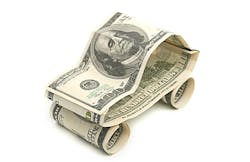Don Clack strives to have his parts department work with clockwork efficiency. That’s especially evident when Clack, the parts manager at Crain Hyundai Fort Smith (Ark.) has his staff spring into action during an emergency purchase situation.
Clack has forged solid relationships with local aftermarket facilities, like O’Reilly’s, meaning they’re never hesitant to deliver a part to him quickly. And, Clack consistently communicates with co-workers, like porters, letting them know they might have to head out to pick up a part.
“We don’t want that customer to be without their car,” says Clack, who has worked in the industry for 30 years.
Emergency purchases can be a source of frustration for many parts managers, because when they order a part above their dealership’s normal net price—whether the part’s bought from other dealers, or purchased from the factory in a manner that incurs an extra charge—their department’s bottom line can be damaged. And, buying parts from vendors as needed can decrease the efficiency of an inventory.
But Clack, who says he makes emergency purchases daily, has discovered several ways to handle those situations as smoothly as possible. His tricks for handling emergency purchase scenarios include the following:
Develop, and Enforce a Policy.
Hyundai doesn’t charge Clack’s employer any surcharge for warrantied parts, but if an emergency purchase involves a part that’s not warrantied, he wants customers to get a thorough explanation of the freight charges that will likely be incurred.
Clack says his small parts department staff knows that if they order a special-order price that’s not under warranty, they will be charged freight. If that’s the case, the staff makes sure the customer understands how much that freight is going to cost before it’s ordered and paid for, and will ask the customer if he or she wants it overnighted.
Additionally, he implores his co-workers to make sure that, if the dealership orders a part, that it be put on the associated vehicle promptly, otherwise “we’re likely going to be putting it on a shelf for a year or longer,” he explains.
Communicate with Parts Retailers.
Thanks to the solid relationships Clack has forged with retailers around Fort Smith, he can typically get employees at retailers to deliver parts to his workplace within 30 minutes. That fact is of immense value when making an emergency purchase.
“I can place the order electronically, and then call them and say, ‘Hey, I just placed an order for a filter; I need that right now, if you guys can get it over here,” Clack says. “And they communicate pretty well with us.”
Have Clients Prepay, When Possible.
If an emergency purchase part is customer pay and the vehicle isn’t staying at Crain Hyundai Fort Smith, Clack prefers to have clients pre-pay. That tactic, he has learned, ensures that clients return to the dealership rather quickly, to get the part put in their vehicle.
“If it’s an over-the-counter situation, make sure it’s prepaid—and then make sure you call the customer,” Clack suggests. “If you don’t get it prepaid, you’ve got a 50–50 chance you’re going to end up holding that part forever.
“I don’t want it on the shelf if I don’t have to have it on the shelf; that’s a lot of money you’re taking up for one part.”
Make Sure Parts are Properly Receipted.
Clack has developed the following process for documenting emergency purchases: Once the parts arrive, Crain Hyundai Fort Smith receives a "pack slip" from its OEM. On that slip, staff members check off the items received, and go into their DMS to receipt them. Staffers note which customer was involved, which technician is assigned to the job, which part was purchased, when it was ordered, and the fact that the part is now on site.
“Then, we go give that to the service writer that ordered” the emergency purchase, Clack says. “And they, in turn, get the customer here and get the part to the technician.”
Yes, emergency purchases can, in fact, be handled with virtual clockwork precision, once a procedure is in place. The key focus, Clack says, should be getting parts on customers’ vehicles as fast as possible, and out of the parts department.
“You don’t want a bunch of dead inventory; you’re going to get in trouble at the end of the year, if you do” have that, he notes. “You have to keep an eye out on that.”

